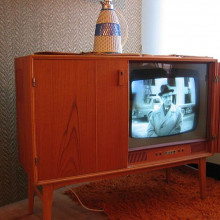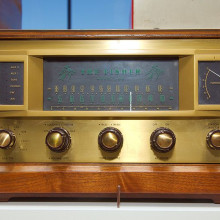Extra Questions - The Science Behind Broadcasting
How does a radio broadcast work? We must have been on your wavelength this week, as we had more questions that we could fit in Naked Scientists Show! Here are the extra bits...
In this episode

Why does bad weather alter digital signal?
Chris - John, what do you think about Roy's issue with weather conditions and sort of deterioration in his signal?
John - Right, well that was specifically about television, but yes it's back to this digital "shelf factor". What is this? In the analogue world, the signal gets better and better as you increase the signal strength, until you get an absolutely noise free signal.
In the digital world, you get perfect signal, until all of a sudden, your decoder says, the signal is a bit weak, I can't make any sense of it. So there are three states in digital television. You've either got perfect picture which may be with quite a small signal; then you get a very marginal signal, which means that the picture breaks up, it goes all blocky, pixelates, and the sound chirps and burbles at you; or you'll get nothing at all. It's just these three states and that's the problem.
So, what it says to me is you're starting off with a fairly marginal signal to start with. You could do with a stronger signal by whatever means, so that when you do get adverse weather conditions and winds blowing your aerial around and what not, then you've got a bit more margin to play with.

How long does it take for radio to reach me?
John - It does depend a lot on the transmission chain that's involved. It depends whether the radio station itself is digital, has a digital sound desk, digital processing amplifiers, and digital transmission lines to the transmitter site. All of these things can add a bit in terms of delay.
Typically, I would say that you'll be talking about less than 50 milliseconds in total for your average radio station. Maybe less than that if you have a completely analogue radio station feeding digital circuits.
If it's an analogue radio station, feeding analogue lines to the transmitter, which of course is analogue, with an analogue audio processor, the delay is virtually zero.
Why don't radio stations interfere?
John - It depends on the frequencies we're talking about. As I mentioned earlier, medium wave has about 120 channels available for use across Europe. It's all coordinated internationally so that some countries have a preferred frequency for high power stations and then other countries can use these frequencies again, but only on low power.
So for example, if we were to take radio 5 live which is on medium wave across the UK, it has two primary frequencies, 693 and 909 kilohertz. These are high power channels, so these would have maybe half a dozen transmitters on each of these frequencies, and that can cover the UK with a few fillers around and about, on different channels. That means that these frequencies could be used by countries, maybe like south of France or Spain at low power, so long as they don't interfere with the national service.
In terms of local radio, nearly all the local radio frequencies we use on medium wave are re-used frequencies. So in other words, another country has these frequencies as its high power allocation and we're allowed to use it on a non-interference basis. What that means is, we mustn't interfere with them. That doesn't mean to say that they mustn't interfere with us because they are the primary users and as I said earlier, the after dark problems, sky wave propagation means that quite often, you might be listening to radio Norfolk on 855 kilohertz, you can hear a Spanish station quite strongly in the background.
How do we site radio transmitters?
John - That is exactly what happens, in fact. If you get midway between two transmitters of similar power, even though we synchronise the transmitters so that they're absolutely in phase and audio is delayed such that they get to their transmitters at the same time, you will still get a situation where you'll get horrible phasing distortion.
A good example of how we dealt with this was radio 4 long wave which has 3 transmitters, one in Droitwich, near Birmingham, one at Westerglen between Glasgow and Edinburgh, and one at Burghead near Inverness in Scotland. All of these operate on 198 kilohertz. What they do is they steer the audio delay such that they can create a mush area in centres where there's hardly any population.
So, if you were to take the difference between Westerglen and Droitwich, the mush area tends to be around Cambria. But how to deal with that is to put a medium wave filler in that area so that although you got horrible radio 4 long wave signal, you get a medium wave alternative. Likewise, the delay between Westerglen and Burghead is steered, such that the mush area is in the highlands of Scotland where the population is very low. Chris - What about with FM networked radio? They're using different frequencies in different parts of the country to avoid that problem aren't they? I've noticed that when I drive from one part of the country to another, I'll stay tuned to the same network radio programme, but my fancy radio would retune itself to a slightly different frequency between the two places on my journey.
John - That's right. Each national network occupies around about 2.2 megahertz worth of space on the FM dial. So, 5 national networks Radio 1, 2, 3, 4, and Classic FM. They all get around just over 2 megahertz each to plan the national networks. So that comprises quite a number of transmitters at high power that cover the bulk of the population and in lots of low power fillers in between, but they have to be on different frequencies because as I said earlier, it's an analogue system. If you get two transmitters on the same frequency that don't arrive at the same time at the receiver, you get distortion and all sorts of nasty noises. So that's how they deal with that on FM.
Who decides DAB bit rate?
John - In the early days when the Eureka 147 project was launched, the plan was that they would have high quality services of 256 kilobits and maybe a compromise will be 192kb. The difficulty with that is commercially, that didn't make it all that attractive because there weren't really very many more channels than we could get on the FM dial. To make DAB attractive, they wanted more stations particularly in the commercial sector. So, the way to do that with a finite amount of bandwidth is to reduce the bit rate of each station until you could squeeze more channels in. That's an advantage of DAB really that you can dynamically control the bandwidth used by stations. So for example, when radio 5 Live has a special going out of 5 Live Sports Extra, they will change the bit rate of 5 Live. Likewise Radio 4 FM carried on DAB will have a certain bit rate normally, but when the morning service goes out on the Radio 4 long wave version on DAB or Today in Parliament is broadcast then the bit rate is squeezed down, and it goes into mono so that you can maximise the choice for the bandwidth available.
Yes, quality does vary station to station. Some stations are using as little as 64 kilobits which does not produce very pleasant effects. It restricts you to mono, the old mpeg coding, it doesn't perform well at these bit rates. However, there's something else I might talk to you about and that's DAB plus which is a means by which you can use even lower bit rates and get reasonable sound quality, but the UK isn't adopting that.
Chris - Why not?
John - The problem is backwards compatibility. If you have a radio that you bought before 2008, the chances are, it would not be able to decode DAB plus. So all these people who have gone out in good faith and bought their DAB radios would find they wouldn't be able to get their DAB plus stations. And of course, the longer we leave it, the more difficult it becomes because ever more people have bought sets that might not be compatible. Other countries are looking at that and introducing DAB plus, but that's because they're not so far ahead in getting DAB launched in the first place. I can give you a parallel of freeview HD and freeview. If you have a free view box, you cannot decode free view HD. However, a free view HD box will decode basic freeview.
What will the FM bandwidth be used for?
John - Well, if this all goes ahead - the plan to migrate most radio listening to digital and by that, we mean DAB primarily - it does free up the space on FM band. What's been said so far is that local radio stations that cannot afford to get on DAB, small scale community stations as well, as small scale commercials, they would remain on FM.
Chris - But the license for a national DAB station is not very expensive. It's only about - I was talking to someone the other day about this actually - they said it's about Ã?,£500,000 for a a national DAB license. At the moment, people are spending significantly more than that on an FM licence.
John - Well, I don't think that's the case in the smaller scale radio stations. I'm talking about city wide stations which work on a very tight budget with maybe 3 or 4 staff, a bit like a commercial version of community radio which of course is run on an essentially voluntary basis. They just do not have the funds to do it. They have tried going on to local DAB multiplexes in some areas, but they find the cost prohibitive and the listenership, not very great.
Chris - This is quite funny, isn't it, that everyone strove for FM and now FM is going to become the poor person's radio, where at the moment, everyone wants to be on FM. They're all going to over to digital, we would expect, and this means that then you'd use that capacity for lower budget operations into the future.
John - It's a curious development, yes. It's quite different to the model for analogue television switch off where there was a digital dividend quite clearly payable there. What we mean by that is, they were able to re-use some of the frequencies that were previously required in the analogue world which were no longer required in the digital world, and that will allow us to roll out for example, 4G, wireless radio mics in different bands and the like. The FM band between 87.5 megahertz and 108 megahertz, it's difficult to see what commercial value that has outside conventional analogue broadcasting.










Comments
Add a comment